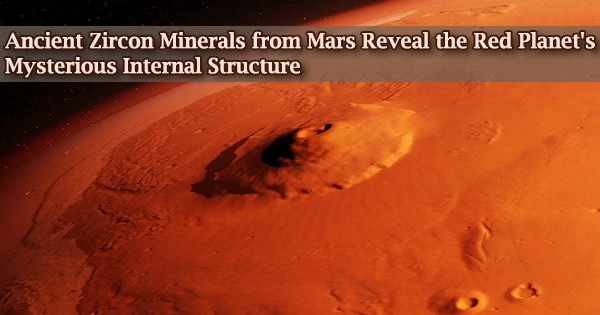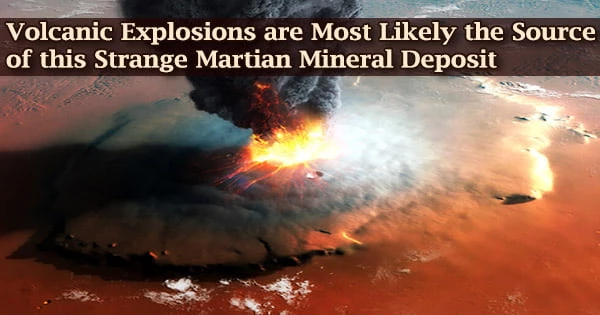The uranium-bearing mineral zircon is a common component of Earth’s continental crust, and it can reveal details about the continents’ age and origin, as well as massive geological phenomena like mountain chains and giant volcanoes.
However, unlike Earth, Mars’ crust has not evolved and is comparable in composition to the crust found beneath the oceans of Earth, where zircon is scarce. As a result, zircon is unlikely to be a prevalent mineral on Mars.
“We were quite surprised and excited when we found so many zircons in this martian meteorite. Zircon are incredible durable crystals that can be dated and preserve information that tells us about their origins. Having access to so many zircons is like opening a time window into the geologic history of the planet,” describes Professor Martin Bizzarro from the GLOBE Institute, who led the study.
The researchers looked at the ancient Martian meteorite NWA 7533, sometimes known as “Black Beauty,” which was discovered in the Moroccan desert in 2011. They extracted roughly 60 zircons after crushing 15 grams of this rock.
They discovered that the majority of zircons date back to around 4.5 billion years ago, indicating that the planet’s life began there. But they also discovered something unexpected: some of the zircons had ages ranging from roughly 1500 million years to 300 million years.
“These young ages were a great surprise,” says Bizzarro. “The Black Beauty meteorite is believed to come from the southern hemisphere of Mars, which does not have any young volcanic terrains. The only possible source for these young zircons is the Tharsis volcanic province located in the northern hemisphere of the planet, which contains large volcanoes that were recently active,” Martin Bizzarro adds.
The Tharsis bulge on Mars is a massive volcanic province that is home to the Solar System’s tallest volcanoes, which can reach heights of up to 21 kilometers. This volcanic province, scientists believe, is the result of very deep magmatism erupting on the planet’s surface. On Earth, the Hawaiian volcanic chain of islands is a good parallel, as it is likewise thought to reflect the deep-seated volcanic activity.
The Pacific Plate, however, is continually moving due to plate tectonics, and instead of collecting at a single site, a chain of progressively younger volcanic islands has been created. Because there is no plate tectonics on Mars, the volcanoes pile up in one place and grow to enormous proportions.
Having samples of the deep interior of Mars is key. This means that we can now use these zircons to probe the origin of the volatile elements on Mars, including its water, and see how it compares with Earth and other planets in the Solar System.
Mafalda Costa
If Bizzarro and his team are correct, the youthful zircons could hold information about Mars’ deep, inaccessible interior. This is the first time scientists have had direct access to Mars’ deep interior via these samples, which could help them learn more about the planet’s fundamental structure and makeup.
“Having samples of the deep interior of Mars is key. This means that we can now use these zircons to probe the origin of the volatile elements on Mars, including its water, and see how it compares with Earth and other planets in the Solar System,” explains Mafalda Costa, first other of the new study.
However, to learn more about the nature of the deep martian interior, scientists looked at the isotopic makeup of the element hafnium in the same zircons.
“Because hafnium is a major elemental constituent of zircon, it retains a memory of where the zircon formed,” says Martin Bizzarro.
“We found that the hafnium isotope composition of the young zircons is unlike any of the known Martian meteorites, which indicates that the young zircons come from a primitive reservoir that we did not know existed in the interior of Mars,” he adds.
The youthful zircons’ hafnium isotope makeup is similar to that of the Solar System’s most ancient objects, chondrite meteorites. These chondrite meteorites are fragments of asteroids that have never been altered since they were formed.
This means that since the planet’s birth, the deep interior of Mars has remained mostly unchanged. For a planet without plate tectonics, the presence of such a primordial reservoir is expected.
In contrast to Earth, where plate tectonics continuously recycles material created at the surface into the inside, the deep interior of Mars has stayed untouched since the planet’s creation, preserving its original composition.
Finally, the fact that zircon may be prevalent on Mars’ surface could help guide future robotic exploration of the planet, particularly in terms of returning samples to Earth.
“Our study makes clear that a return mission targeted at acquiring zircon-bearing samples will be of high scientific value towards understanding the geologic history of Mars,” concludes Martin Bizzarro.
The Carlsberg Foundation, the Danish National Research Foundation, and European Research Council supported the study.
















